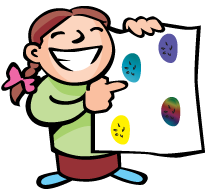Boston Children's Museum
308 Congress Street, Boston, MA 02210
617-426-6500
© Boston Children’s Museum 2025
Website Design by JackrabbitPrint making is the process of transferring an impression from 1 object onto the surface of another. In this activity, students will learn that a single object can be used to make infinite images of that object. They will gain a basic understanding of the printing process and will explore the printing possibilities of natural objects, specifically familiar fruits and vegetables. Printing with these items will also help students sharpen their observation skills as the results will accentuate details they may not have noticed before.
Purchase a variety of fruits and vegetables. Some good choices are apples, oranges, star fruits, kiwi fruits, carrots, mushrooms, broccoli, green peppers, avocados and pomegranates. Prepare the fruits and vegetables by cutting them in half. Some foods (like apples and oranges) look different if you cut them from top to bottom than they do if you cut them from side to side. Try both and have children observe the differences. Cut the fruits (especially the citrus fruits) a few hours ahead of time so that they dry out a bit.
Squirt a small amount of each color of paint onto a few plates and spread the paint out on the plate. When you distribute the paint, have 4–6 students share a set of plates with different colors. Do not prep these plates too far in advance—the paint will dry up! Place newspaper on the tables to keep them clean.

Ask your students if they have ever made a “print” before (if you have done the Print Making activity, you can ask them about the objects they used to make prints.) What is a print? A “print” is an image that is created when a stamper or object is inked and pressed onto paper. Can they think of something they have seen before that was printed?
Create colorful prints using fruits and vegetables!
After each student has created a print or two, bring the whole group together to talk about what they have tried. What did they notice? Did anyone try something that made an interesting print? Did anyone discover something that made their print turn out differently than they had expected? What happens if you use too much ink? What about multiple colors? What happens if you press down too hard on the piece of fruit or vegetable, especially soft ones like mushrooms or kiwi fruit?
Send students back to make some more prints. When they are done, invite them to tape their prints up on the wall, and ask kids to look at everyone else’s prints.
Some other ideas for making prints with food: